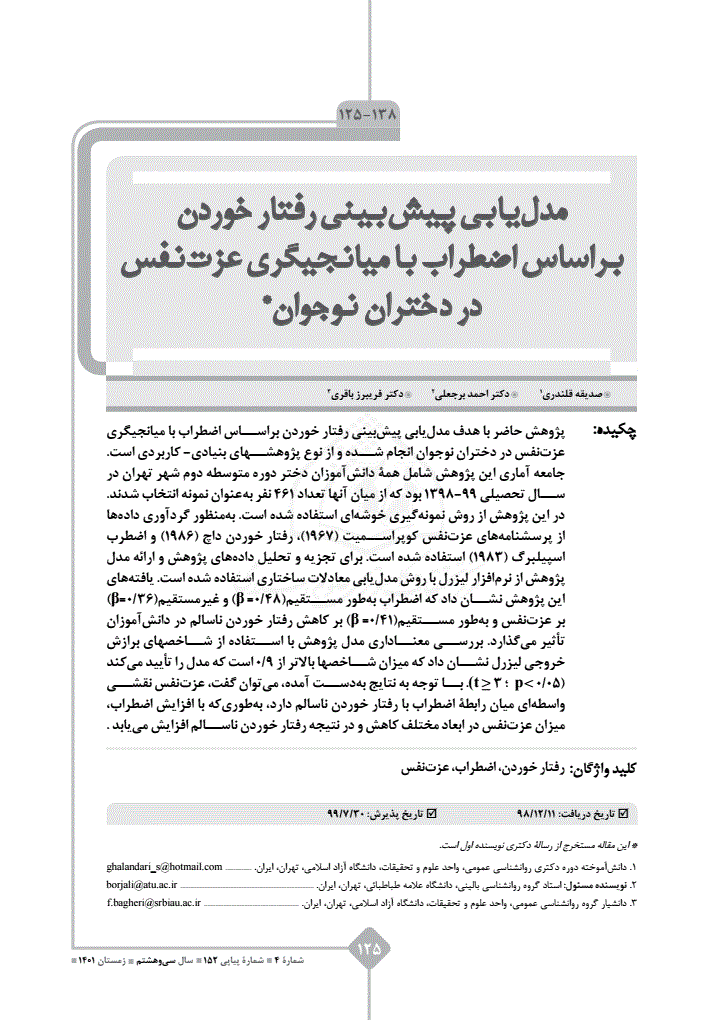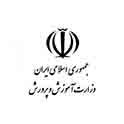Abstract:
پژوهش حاضر با هدف مدلیابی پیشبینی رفتار خوردن بر اساس اضطراب با میانجیگری عزتنفس در دختران نوجوان انجام شده و از نوع پژوهشهای بنیادی- کاربردی است. جامعه آماری این پژوهش شامل همۀ دانشآموزان دختر دوره متوسطه دوم شهر تهران در سال تحصیلی 99-1398 بود که از میان آنها تعداد 461 نفر بهعنوان نمونه انتخاب شدند. در این پژوهش از روش نمونهگیری خوشهای استفاده شده است. بهمنظور گردآوری دادهها از پرسشنامههای عزتنفس کوپراسمیت (1967)، رفتار خوردن داچ (1986) و اضطرب اسپیلبرگ (1983) استفاده شده است. برای تجزیه و تحلیل دادههای پژوهش و ارائه مدل پژوهش از نرمافزار لیزرل با روش مدلیابی معادلات ساختاری استفاده شده است. یافتههای این پژوهش نشان داد که اضطراب بهطور مستقیم (0/48=β) و غیرمستقیم (0/36=β) بر عزتنفس و بهطور مستقیم (0/41=β) بر کاهش رفتار خوردن ناسالم در دانشآموزان تاثیر میگذارد. بررسی معناداری مدل پژوهش با استفاده از شاخصهای برازش خروجی لیزرل نشان داد که میزان شاخصها بالاتر از 0/9 است که مدل را تایید میکند (0/05> p ؛ 3 ≤ t). با توجه به نتایج بهدست آمده، میتوان گفت، عزتنفس نقشی واسطهای میان رابطۀ اضطراب با رفتار خوردن ناسالم دارد، بهطوریکه با افزایش اضطراب، میزان عزتنفس در ابعاد مختلف کاهش و در نتیجه رفتار خوردن ناسالم افزایش مییابد.
The present research, which is of the basic-applied kind, has aimed to find a model for predicting anxiety-based eating behaviors with self-esteem interventions in adolescent girls. The statistical population consisted of all female senior high school students in the city of Tehran during the school year 2019-2020, 461 of whom were selected as the sample. Clustered sampling was used as the sampling method. The Coopersmith Self-Esteem Inventory (1967), the Dutch Eating Behavior Questionnaire (DEBQ) (1986) and Spielberger’s State-Trait Anxiety Inventory (1983) were used for data collection. To analyze the data obtained and present the research model, SPSS software along with structural equation modeling have been used. The findings of the research show anxiety to be directly (β= 0.48) and indirectly (β= 0.36) influential upon self-esteem and directly (β = 0.41) influential upon the reduction of unhealthy eating behavior in students. Studying the significance of the research model using the fit indices from the LISREL output indicated indices higher than 0.9, thus confirming the model (t≥3; p
Machine summary:
يافته هاي اين پژوهش نشــان داد که اضطراب به طور مســتقيم (٠/٤٨= β) و غيرمستقيم (٠٣٦=β) بر عزت نفس و به طور مســتقيم (٠/٤١= β) بر کاهش رفتار خوردن ناسالم در دانش آموزان تأثير مي گذارد.
بررســي معنــاداري مدل پژوهش با اســتفاده از شــاخصهاي برازش خروجي ليزرل نشــان داد که ميزان شــاخصها بالاتر از ٠/٩ است که مدل را تأييد مي کند (٠/٠٥ چکيده : کليد واژگان : رفتار خوردن ، اضطراب ، عزت نفس تاريخ دريافت : ٩٨/١٢/١١ تاريخ پذيرش : ٩٩/٧/٣٠ * اين مقاله مستخرج از رسالۀ دکتري نويسنده اول است .
Pentikäinen, Arvola, Karhunen & Pennanen 4.
Thorpe, Kestin, Riddell, Keast & McNaughton 12.
Anderson, Wong, Lanciers & Lim 13.
Darfour-Oduro, Buchner, Andrade & Grigsby-Toussaint 15.
از اين رو، هدف از مطالعه حاضر مدل يابــي پيش بيني رفتار خوردن براساس اضطراب با ميانجيگري عزت نفس در دختران نوجوان بوده است .
Cvencek, Fryberg, Covarrubias & Meltzoff 3.
همچنين عزت نفس به طور مستقيم سبب کاهش رفتار خوردن ناسالم در نمونه پژوهش شده است (٠/٤١= β).
Gaddad, Pemde, Basu, Dhankar & Rajendran 3.
Çolpan, Eray, Eren & Vural 4.
Iannaccone, D’Olimpio, Cella & Cotrufo 4.
براســاس نتايج حاصل از اين پژوهش ، اضطراب و عزت نفس عواملي مؤثر در زمينۀ رفتار خوردن اند.
Relationship between body dissatisfaction and disordered eating: Mediating role of self-esteem and depression.
Self-esteem, body shame and eating disorder risk in obese and normal weight adolescents: A mediation model.
Socializing problems and low self-esteem enhance interpersonal models of eating disorders: Evidence from a clinical sample.

(پژوهیار,
,
,
)

